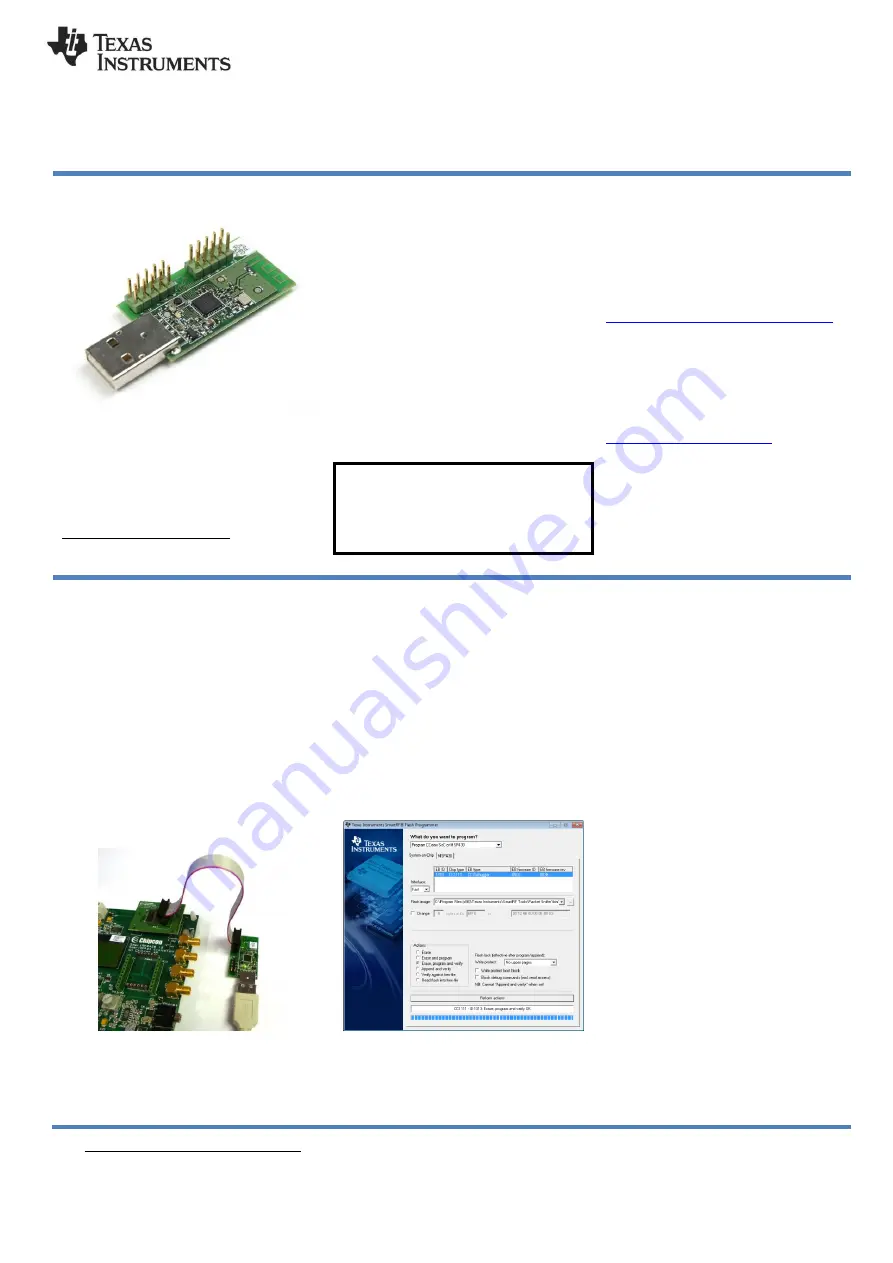
September 2013
CC2511 USB Evaluation Kit Quick Start Guide
1. Kit Contents
1 x CC2511 USB Dongle
This Quick Start Guide
The hardware in this kit is FCC and IC certified
and complies with ETSI/R&TTE requirements
over temperature from 0 to +35°C.
FCC/IC Regulatory Compliance
FCC Part 15 Class A Compliant
IC ICES-003 Class A Compliant
2. Getting Started
The CC2511 USB Dongle can be
used as a development platform for
USB and RF applications.
An external development board or
debugger, like the CC Debugger,
SmartRF04EB or SmartRF05EB, is
required to program and debug
software running on the CC2511.
Note that the CC2511 USB Dongle is
pre-programmed with the packet
sniffer firmware.
This
Quick
Start
Guide
will
describe how to use the dongle
with the packet sniffer and what
would be the next steps for
developing your own software.
3. Preparations
Before
proceeding,
please
download and install the following
tools:
SmartRF Flash Programmer
www.ti.com/tool/flash-programmer
You will need this tool to program
the packet capture firmware on the
CC2511 USB dongle
SmartRF Packet Sniffer
This is the PC tool that displays
and parses the packets received by
the capture device.
4. Programming the Dongle
For the USB dongle to operate as a
packet capture device, it must be
programmed with the packet sniffer
firmware. By default, the dongle comes
pre-programmed with this firmware.
Connect the USB dongle to the
debugger or the development board
with an appropriate 10 pin flat cable.
The dongle must also be powered via
the USB bus. Refer to picture below
for an example.
Caution!
Avoid using other power
sources
1
for the dongle than a regular
USB voltage source at max 5.5V, 500
mA, (efficiency level V).
5. Programming the Dongle
Launch
the
SmartRF
Flash
Programmer and make sure you
select
the “System-on-Chip” tab. The
tool should show a line with CC2511
connected to a SmartRF04EB.
Next, locate the flash image
sniffer_fw_ccxx11.hex
in
“C:\Program Files\Texas Instruments\SmartRF
Tools\Packet Sniffer\bin\general\f
irmware”
Select “Erase, program and verify”
and press the “Perform Actions”
button.
6. Install USB Driver
After programming the device,
disconnect the dongle from the
programming board and plug it into
the PC.
Windows’ new hardware
wizard will appear.
Select the options for automatic
installation and wait for the driver
installation to complete. If the
Wizard asks for a specific driver,
point it to the cebal2.inf file located
in
“C:\Program Files\Texas Instruments\SmartRF
Tools\Drivers\cebal\win_<arch-specific>\
”
After installation of the driver, the
Packet Sniffer capture device is
ready for use.
1
When using an external power supply, make sure it meets the listed requirements in addition to complying with
applicable regional product regulatory and safety certification requirements such as UL, CSA, VDE, CCC, and PSE.






